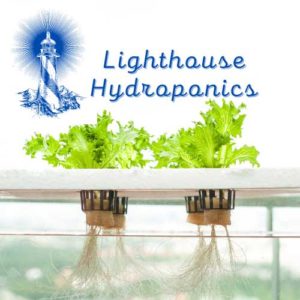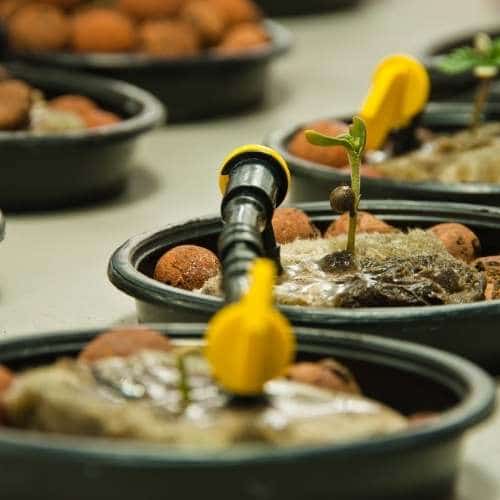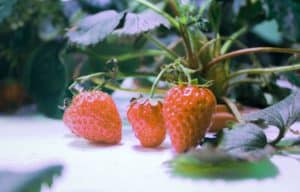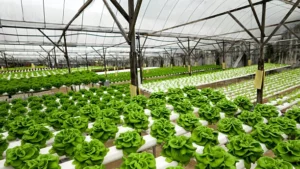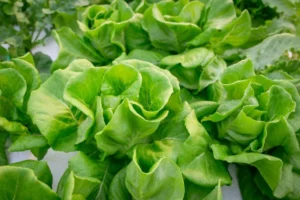If you are new to hydroponics, then this guide on hydroponics for beginners is for you. It may seem intimidating at first to make your own hydroponic system. You may think you will need lots of special tools. Or perhaps you think that it will be costly to set up or the whole process is complicated. There are many things you can learn about hydroponics, and there is no doubt some people still find this complicated.
However, you don’t have to become a professional to grow plants hydroponically. You can make your own system without spending much at all and really enjoy the process.
With some research, you’ll be able to find the best hydroponic system for your taste and needs. You can also make your own with some basic supplies. Your hydroponic system can be as small or big as you like and be as high-tech or simple as you prefer and you can decide ahead of time if you want to go all in with an expensive system or go shoestring budget style.
How Does a Hydroponic System Work?
The term Hydroponics comes from two words, hydro and ponos, meaning water and work. In hydroponic systems, water, combined with nutrient solutions, do all the tasks to grow plants without soil.
A passive irrigation setup is a good example of a hydroponic system.
In this setup, herbs are held in place through a growing medium. You can use a soda bottle as the water tank to hold the growing medium and the water, which is in the base compartment. You can put a small grow light to this setup, and that’s it. You now have a working hydroponic mini garden.
Why Grow Hydroponically?
There are a lot of reasons for growing plants hydroponically. The most common ones are without a doubt
- faster growth and
- utmost yield.
In a well-working hydroponic system, plants must get the right amount of water, light, and nutrients.
If plants get their basic needs met without exerting their energy on extracting nutrients from the soil, plants can devote their energy and resources to just growing. No wonder this is considered the most effective way of growing plants.
Another amazing reason to grow plants hydroponically is that it solves the problem of lack of soil and space. Anyone with an indoor garden knows how muddled it can get. Trying to plant, transfer or fertilize plants on a table or kitchen counter can easily create small chaos. Certainly, this may involve some stray clipping or spilled water. However, the mess is easier to clean than soil getting mud in the rug or carpet.
Choosing a Hydroponic System
There are many kinds of hydroponic systems that every beginner should know. These hydroponics systems use nutrient solutions and water and don’t use soil. Basic elements are similar, but every system provides these needs only a little differently.
Water Culture
This is considered one of the cheapest and simplest types of hydroponic. The herb is put in a basket on top of a reservoir filled with nutrients. The roots hang down, totally soaked in the nutrient solutions. As the roots are soaked constantly, they will need aeration to avoid suffocation and rot. This can be achieved using air stones, an air pump, or a falling water system that creates air bubbles.
Nutrient Film Technique (NFT)
This is easy to set up. This system includes a narrow flow of nutrient solution that flows in a downward-sloping channel. Plant roots hang into the system and assimilate nutrients from the constant flow. This is superb for small and fast-growing plants such as baby greens, herbs as well as lettuce.
Aeroponics
This system makes a setting for the roots, which supplies them with more oxygen. Here, the roots hang in midair in a growing hollow or compartment with no growing medium, so the whole root system is exposed. In the growing compartment, roots are sprayed regularly with a spray of nutrient-rich water.
Ebb and Flow
This method makes use of a water pump on a timer. It floods and drains the root system with nutrients and water. The water reaches a height where it will submerge the roots. The excess water will drain into an overflow tube. If the pump stops, the water will drain back down to the tank. It remains there until the pump starts working again. This gives the roots an alternating time of oxygenated air and nutrient-rich water.
Drip System
This is a relatively simple idea, and it functions precisely as it sounds. The root of the plants is put in a growing medium such as gravel or perlite. Then, nutrient solution and water are pumped from a tank via tubes to drip to the roots. Roots and growing medium are soaked, and then the nutrient solution drips back into the tank and flows to the tank. This is perfect for bigger plants with wide roots. It functions well, as the growing medium holds the moisture and thus keeps big roots well-hydrated.
Wick System
This system is very simple and straightforward. Plants sit in a wicking medium like perlite or vermiculite. They’re put in a container straight on top of the nutrient solution and water reservoir. Strips or wicking ropes are then used to link the solution and the wicking medium. This way the medium never dries out, because thanks to physics, it has a constant supply of water and solution which are pulled up through the wicking strips. No moving parts or pumps are needed with this system.
How do I start a hydroponic system?
To start learning how to build a hydroponic system, there are important things that you need to bear in mind:
Secure the Materials
One drawback of hydroponic is the initial investment that you will need. Even if you might need to give it out at the start of your project, you will also reap its perks for a long time. When creating hydroponics, you will need a plastic tank or reservoir, a water hose, an air stone, a bucket, and an air pump.
Check the Space
You might not need a space of soil to till; however, you will need space for the setup, even if it won’t be too spacious or too big.
What Plants to Grow
Choose the crop you wish to grow in your hydroponic garden. Among the good in hydroponics are cucumber, strawberries, lettuce, tomatoes, and a lot more. You can also grow herbs.
Pick the Right Hydroponic System
As mentioned above, beginners’ easiest and best hydroponic systems are the wick and DWC systems. Of course, you can choose one that your find most suitable to your preferences, just remember to think of the expenses and how simple it is to make.
Make Sure You Have the Proper Environment
Even though plants can survive (and thrive) in hydroponics without soil, they still need light to grow healthy. If you’re looking for a suitable space for your hydroponic garden, make sure that the plants are getting a decent amount of light – whether from the sun or by using an electric grow light.
Can I use tap water for hydroponics?
Many people know that hydroponic is growing plants that lack soil. Instead, the root is either supported in a growing medium. One most common mistakes beginners make before fully researching hydroponic is the application of tap water. So, this begs the query of whether you can use tap water from your faucet in hydroponic systems.
You can certainly use tap water for hydroponics. However, not as it is. Plant growers need to take extra steps to keep plants safe from harmful minerals and chemicals which may be present in the water and negatively affect the crops’ well-being.
So use a pH meter and treat the water to get the right pH balance and the right level of filtering that your plants need. In short, tap water is a fine start, but only a start.
How often should hydroponic plants be watered?
The answer to this question depends on the kind of crops being grown, their sizes, and the specific system you are using. Remember, plants are extremely particular about being under or over-watered, so this is a vital question.
First and foremost, you have to determine if the growing medium you use is repellant or absorbent. If you are utilizing Rockwool, you’re dealing with an absorbent medium, while Hydrocorn is a perfect example of a repellent that does not hold too much water. You need to keep your medium moist but not soaked or if you wish your medium to dry out between watering. Therefore, if you see plants or crops before and after watering, it will be easy to determine if you’re watering too little or too much. If you notice that the plants are sagging before watering, and then immediately perk up after watering – you might need to water them more often. Once the crops wilt after watering, then it shows that you overwater them. Thus, you need to allot more time in between watering. The best advice is to water plants about two to three times a day.
How often do you change the water in hydroponics?
If you are just getting into this kind of gardening or simply want to ensure the crops are in good condition, you have to keep or maintain the water system. An important part of this is ensuring you have appropriate nutrients, clean water as well as a pH level.
So, how often must you change the water in your hydroponics system? The answer to this question is that water must be changed out every 2 to 3 weeks. It all depends on the system you set up. You might change the water more or less often in order to maintain optimal nutrient and pH levels.
The occurrence with which you change the water in your hydroponic system is very vital. On the other hand, how do you change it? The time of the changing of the water is more complex than just dumping as well as replacing the water weekly or bi-weekly.
If you fail to change the water in your hydroponic system as often as you should, pH levels, nutrients as well as other ratios will not be balanced. A discrepancy ratio can affect the growth of the crops and encourage the occurrence of damaging and detrimental organisms, making an environment that could result in killing your crops.
How deep should roots be in hydroponics?
When it comes to how deep roots must be submerged in a hydroponic system, first and foremost, you need to ensure that just the root matter is soaked in the nutrient solution. There is no stem and certainly no vegetation. You do not want to soak the roots either totally. You can keep about 1 to 1.5 inches (3.81 centimeters) of the root above the waterline. Bubbles produced by the air stone will usually pop, and the water will land on the vegetation roots which are not soaked. Therefore, there is no need for you to worry about the roots drying out.
In DWC hydroponic system, there’s no minimum for depth provided that you have space for the roots to grow and which can be room crossways. There are plants cultivated in growing trays that were three inches deep- the roots simply spread in the base of the growing trays identical to an NFT.
What liquid is used for hydroponics?
Actually, the answer to this question depends on the source of the water. Tap water might contain chemicals or substances utilized to purify it, and water from the well may have natural minerals, which vary in ways that you are not able to see.
Tap water is a good choice to start with. However, make sure to filter it prior to using it. There are a lot of techniques, from carbon-based filters to a complex reverse osmosis system. The disparities are about convenience. Whichever you choose, the outcomes are almost the same, liquid which is close to a pure state.
Appropriate pH for a nutrient solution is vital for the crops to take up the most efficiently. Therefore, you need to test the liquid first before utilizing it and adjust as required.
